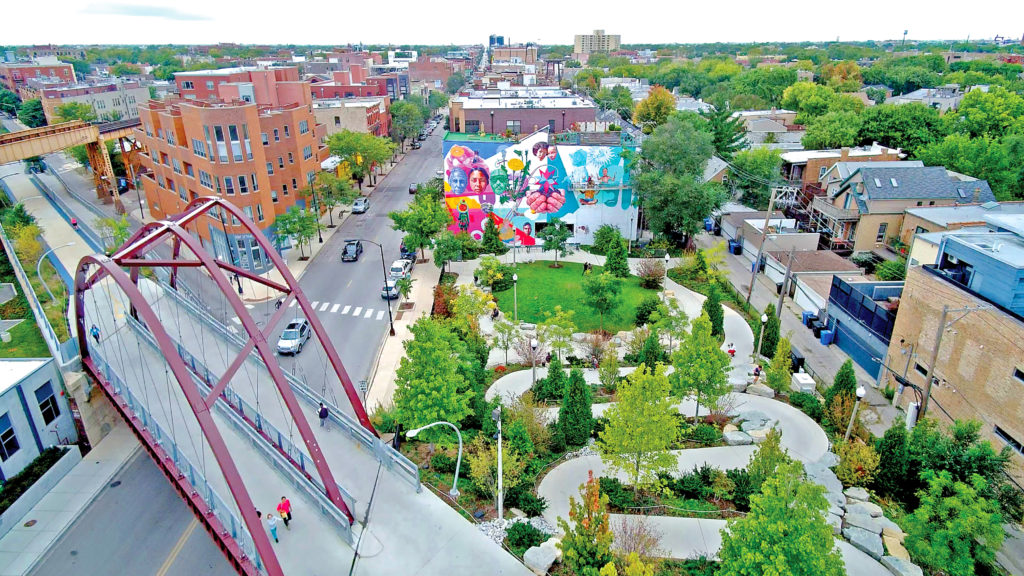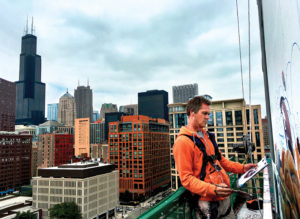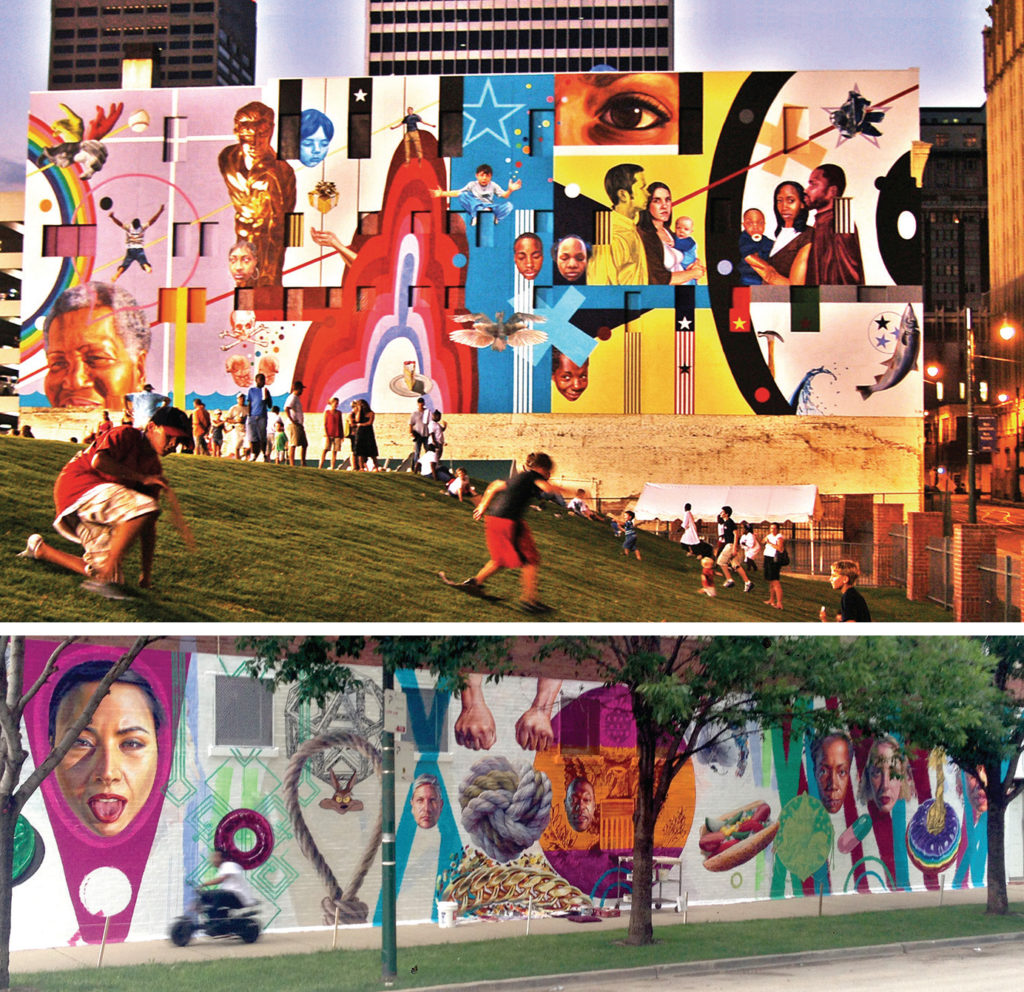People’s Muralist
 Jeff Zimmermann has produced as many as 20 murals, some of which are 10 stories high. (Image by Kenn Rhem)
Jeff Zimmermann has produced as many as 20 murals, some of which are 10 stories high. (Image by Kenn Rhem) At first glance, Jeff Zimmermann’s latest mural, in Chicago’s Humboldt Park neighborhood, is cryptic. There’s a top hat, a candy cane, a pair of high-top sneakers, a pile of SpaghettiOs. And a blue mass of what the artist explains is extruded toothpaste. The piece is entitled “The Party.”
Zimmermann, FAA ’92, brings the mural all together: It’s a youth being shot, recoiling from the impact of a bullet. The top hat and cane are icons of the Vice Lords, one of Chicago’s oldest street gangs. The hat is tilted, as if recently blown off someone’s head. Under the hat is blue toothpaste—gel toothpaste, something a kid might use—piled in the shape of a brain. The sneakers are Air Jordans, shoes so popular in the late 1980s that teenagers were killed for them. And the pasta? It’s a reference to Ren and Stimpy, the famously gross 1990s cartoon, where the SpaghettiOs depict, obviously, something gross.
A viewer might be forgiven for not catching all that. Actually, the artist prefers it that way. “My murals are completely puzzling,” Zimmermann says. “Hopefully, when you see my mural you go, ‘I don’t know—what the hell?’ If they get it right away,” he adds, “people don’t look at it anymore. It becomes a tree or something. You just walk right by it. People want to think. They want to use their imagination.”
Zimmermann, who majored in art history and computer design at Illinois, has been puzzling Chicago residents for more than 20 years. An accomplished graphic artist and muralist, he has been hired for high-visibility projects sponsored by Wrigley Field and packaged-foods giant Conagra Brands. He once custom-designed a pair of sneakers for LeBron James that used one of Zimmermann’s favorite motifs: a Chicago-style hot dog.
In 2003, Chicago’s Museum of Contemporary Art exhibited his 72-foot-long piece, “Dark Matter.” It required three full walls of a large gallery. The Chicago Cultural Center also has shown his work. “He’s an exceptionally talented painter and an important contributor to the Chicago cultural scene,” says Nathan Mason, art curator for the city’s Dept. of Cultural Affairs and Special Events. Zimmermann also worked in Honduras, where he was part of a United Nations-sponsored artist exchange, and in Kenya and Peru.

The Conagra Brands mural overlooks a park that serves as the entry point to the elevated 606 Trail in Chicago’s Bucktown neighborhood. (Image courtesy of Jeff Zimmerman)
The artist is lively company, constantly filling the conversation with anecdotes about his art and the neighborhoods he has lived in. A young-looking 46, he grew up in the Chicago suburb of Westchester, but has spent most of his adult life in the city—mostly in poorer neighborhoods, although gentrification seems to follow him.
As a youth, Zimmermann enjoyed doodling to entertain friends, but never took art seriously. His sister suggested he study art in college. He added computer design as something to fall back on, and began focusing on graphics. After graduation, he spent two years with the Jesuit Volunteer Corps in a shantytown in Peru, working with street children.
In 1996, after he returned to Chicago, Zimmermann volunteered to teach art to Spanish-speaking at-risk teens in the Pilsen neighborhood. A pastor invited him to paint a mural on a four-story apartment building at 19th and Ashland. “I had never painted before,” he says. “But I told him yes. We got some scaffolding and figured it out. I taught myself how to paint at the same time.”
At the time, Pilsen was largely a Hispanic neighborhood, and Zimmermann wanted his mural to reflect the views of its residents. He talked to them about their lives and histories, and came up with a mural that included people swimming across the Rio Grande and Our Lady of Guadalupe, Mexico’s patron saint.
The job took all summer. Four years later, he added two more panels showing Mexicans graduating from college and working as doctors, teachers and chefs, reflecting the hopes and dreams of the community. “I didn’t make any money,” he says, “but it was a great time, meeting people in the street. I said, ‘Heck, I’m going to become an artist.’”
There’s a long history of Chicago murals. Starting with the Progressive Era in the early 1920’s, inspiring murals were installed in schools and other public spaces. During the Great Depression, the Works Progress Administration employed artists as part of FDR’s New Deal. More recently, murals have become an instrument of social change, beginning with the Wall of Respect created in 1967 on Chicago’s South Side.

To paint his murals, Zimmermann uses a scaffold similar to those used by window-washers. (Image courtesy of Jeff Zimmerman)
Zimmermann has painted as many as 20 murals, some up to 10 stories high. Although more than half are gone, painted over by new building owners, he doesn’t mind. “They come and they go,” he says. “There are some that are super-important to me, but there are others (where) I did it, it was cool, I moved on.”
His mural process is complicated. First, Zimmermann photographs his subjects. Then he traces the images onto a transparency. This is projected to its full size on paper taped to a wall in his studio. He traces the images on paper with a magic marker, and “pounces” the lines (perforating them with a tiny, pointed wheel) in preparation for what is to come.
At the building, Zimmermann employs the kind of scaffold a window-washer uses, one raised and lowered via motor and cables installed on the roof (he’s a certified operator). On the scaffold, he primes the wall and tapes up the paper. Then he creates a cartoon of the image by rubbing the perforated lines with charcoal. It’s the same technique Michelangelo used to paint the Sistine Chapel. The paper comes off, and he’s ready to paint. Alone, or with an assistant, he uses acrylic paint with one- to three-inch brushes, occasionally referring to the original photo for details. And he has to work quickly—acrylic paint dries fast.
His work has not been without controversy. In 2009, he was hired to paint a mural at the AutoZone baseball stadium in Memphis. According to a New York Times story, the mural contained a portrait of a black woman with a gold tooth, which some people considered an offensive stereotype. But, the portrait was of a real person—Savannah Simmons, then 80, who later made an appearance at the stadium to celebrate the mural. That put an end to the controversy.

Zimmerman’s mural at the AutoZone Park in Memphis (top), generated controversy because of its rendering of resident Savannah Simmons. (Image by Sophorn Kuoy) The Party mural is located in Chicago’s Humboldt Park neighborhood. (Image courtesy of Jeff Zimmerman)
More recently, a passerby called police after seeing Zimmermann painting “The Party.” The caller didn’t like the fact that the mural contained a depiction of a noose. The noose was, in fact, upside down, and inside the noose was Wile E. Coyote of Bugs Bunny and Road Runner fame—meant to represent the cartoonish way Americans view immigrants, Zimmermann says. Nothing came of the complaint.
These days, Zimmermann continues to seek out new buildings for his murals, and is in discussion with several clients for some high-profile projects around Chicago. He also paints more traditional canvases. A favorite subject today is abstract renderings of crumpled-up potato chip bags, capturing the reflected and shadowy ripples of the Mylar surface.
His next big ambition is a mural 16 stories high—if he can find a way to pay for it.“You’ve got to have a sponsor,” he says. “Or a philanthropist.”

